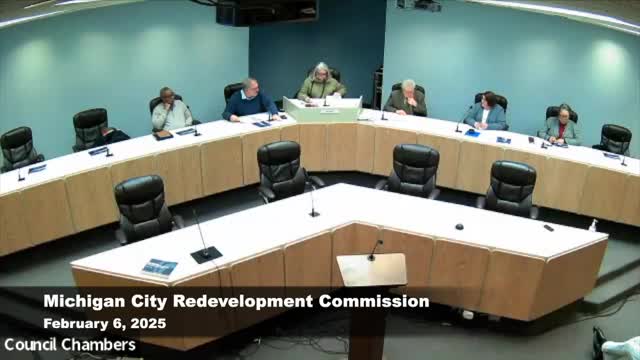Commission debates façade‑grant ‘look‑back’ period; staff to draft revised rules
February 09, 2025 | Michigan City, LaPorte County, Indiana
This article was created by AI summarizing key points discussed. AI makes mistakes, so for full details and context, please refer to the video of the full meeting. Please report any errors so we can fix them. Report an error »

The Michigan City Redevelopment Commission discussed modifications to the façade grant program at its Feb. 6 meeting, focusing on how far back the commission should allow reimbursements for completed work in newly added TIF areas.
Legal counsel and staff summarized the background: the commission expanded TIF boundaries in 2023 and later extended a façade grant program into the newly added boulevard area. Some property owners — represented in the meeting by Hearts and Hands Preschool — completed improvements during the interval between expansion and the formal availability of the program and have requested retroactive consideration.
Alan (Legal counsel) said he prepared draft language to allow a look‑back period and that commissioners at the previous meeting had informally suggested a two‑year look‑back. He summarized the proposed rule: to be eligible for retroactive reimbursement, work must have included permits and active construction or completed qualifying work on or after Oct. 10, 2021 (as drafted for a two‑year window) or, alternatively, tied to the TIF expansion start date of Oct. 2023 if the commission prefers that trigger. "If you are going to agree with the two‑year look back period, you need to make a motion to approve that tonight," he said, while noting the commission could adopt a different period.
Members raised competing concerns. One commissioner (identified in the record as Mayor) said the intent when the TIF expansion and façade tool were created was to start the program from the TIF effective date (Oct. 2023) and give applicants a fixed window to submit applications so the commission would not be faced with claims many years later. Other commissioners argued a limited retroactive window would be fair where applicants undertook work during the short lag between program expansion and final administrative rules.
No final motion was adopted. The commission asked staff to draft written program rules reflecting the discussion — including a recommended start date, an application-processing window and documentation requirements for any eligible retroactive work — and to return the revised narrative and program materials at the next meeting for formal consideration.
The discussion made clear the commission intends to preserve the program’s original purpose (historic-preservation and façade improvement in targeted areas) and to document eligibility criteria so future retroactive requests are handled consistently.
Legal counsel and staff summarized the background: the commission expanded TIF boundaries in 2023 and later extended a façade grant program into the newly added boulevard area. Some property owners — represented in the meeting by Hearts and Hands Preschool — completed improvements during the interval between expansion and the formal availability of the program and have requested retroactive consideration.
Alan (Legal counsel) said he prepared draft language to allow a look‑back period and that commissioners at the previous meeting had informally suggested a two‑year look‑back. He summarized the proposed rule: to be eligible for retroactive reimbursement, work must have included permits and active construction or completed qualifying work on or after Oct. 10, 2021 (as drafted for a two‑year window) or, alternatively, tied to the TIF expansion start date of Oct. 2023 if the commission prefers that trigger. "If you are going to agree with the two‑year look back period, you need to make a motion to approve that tonight," he said, while noting the commission could adopt a different period.
Members raised competing concerns. One commissioner (identified in the record as Mayor) said the intent when the TIF expansion and façade tool were created was to start the program from the TIF effective date (Oct. 2023) and give applicants a fixed window to submit applications so the commission would not be faced with claims many years later. Other commissioners argued a limited retroactive window would be fair where applicants undertook work during the short lag between program expansion and final administrative rules.
No final motion was adopted. The commission asked staff to draft written program rules reflecting the discussion — including a recommended start date, an application-processing window and documentation requirements for any eligible retroactive work — and to return the revised narrative and program materials at the next meeting for formal consideration.
The discussion made clear the commission intends to preserve the program’s original purpose (historic-preservation and façade improvement in targeted areas) and to document eligibility criteria so future retroactive requests are handled consistently.
View full meeting
This article is based on a recent meeting—watch the full video and explore the complete transcript for deeper insights into the discussion.
View full meeting
